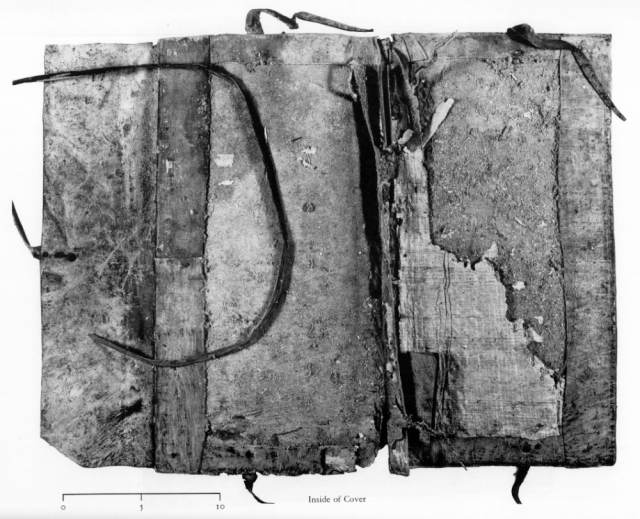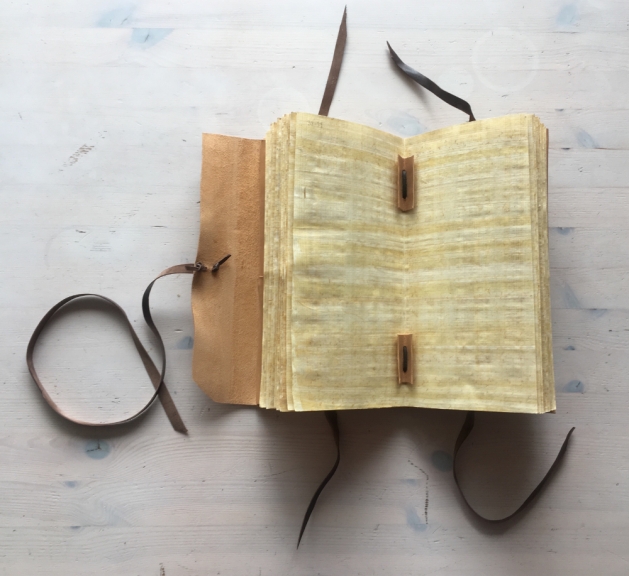As I was writing my book on early Christian manuscripts, one of the most helpful things I did was take up the construction of models of ancient codices. Going through the process of assembling a codex really forced me to understand the literature about ancient books much more thoroughly. I was fortunate to have access to an excellent leather store in Denmark, where I could buy goat skins and a handful of other supplies, and for my first project, I was generously given some good quality papyrus by a friend. I decided to start with Nag Hammadi Codex VI, a single-quire codex with a fairly simple leather cover.
The Nag Hammadi codices are ideal for making models because of the detailed codicological descriptions available in the published volumes. The front matter in the individual volumes of The Facsimile Edition of the Nag Hammadi Codices often contains excellent descriptions, measurements, and photographs of the covers. A couple other more general essays by James Robinson (listed in the “Sources” section at the end of the post) are also quite helpful. For Codex VI, there are really nice images of the book before it was taken apart as well as images of the cover after the quire and the papyrus lining had been removed:

Nag Hammadi Codex VI; image source: James M. Robinson (ed.), The Facsimile Edition of the Nag Hammadi Codices, Introduction (Leiden: Brill, 1984), p. 1*.

Inside of the cover of Nag Hammadi Codex VI; image source: James M. Robinson (ed.), The Facsimile Edition of the Nag Hammadi Codices, Codex VI (Leiden: Brill, 1972), p. 4.
Xeroxing the photos of the cover in the facsimile edition and enlarging them to the proper scale provided a serviceable pattern for the leather parts (measurements are also given in Robinson’s various descriptions).

Analysis of the continuity of horizontal papyrus fibers across the original bifolia allowed for the identification of two rolls of papyrus from which the original bifolia were cut. The width of these bifolia varies, one of the drawbacks of the single-quire format. When one folds a large stack of bifolia, the pieces in the center of the quire tend to protrude. To achieve a uniform fore-edge, the bifolia must either be trimmed after folding or cut from the roll with incremental decreases in width. I used the latter method, and cutting my own papyrus sheets to the correct size was made much easier by the comprehensive list of measurements for the bifolia in the codex given by Robinson:

Note the difference between the width of the outermost bifolium (29.3 cm) and the innermost (26.8 cm). A separate table gives the locations of kollēseis (areas of overlap where the sheets of the papyrus roll were glued together). With this information, it is possible to make a reasonably accurate facsimile of the quire. Once the quire was assembled, all that remained was the construction of the cover and the attachment of the quire.
While the various publications on Codex VI provided a great road map for the project, I did find that some historical imagination was required along the way: What is the most effective way to stab holes through the stack of papyri for the leather tackets? How do I assemble the “waste” papyrus for the stiffening of the cover? And so on. When I ran into trouble, I was lucky enough to receive some advice from the amazing Julia Miller, who has recently written a new book that includes a treatment of the Nag Hammadi codices (I’ll review it here in a few weeks).
One thing that surprised me about the finished product was the durability of the single-quire papyrus codex constructed in this way. It is not easily damaged. One can see how such books might survive for long periods of time in a dry climate.



I’ve since made a few more models. My most recent effort is a model of P.Bodmer II, a multi-quire papyrus codex, which I’ll describe in a later post.
Sources:
Robinson, James M. “Codicological Analysis of Nag Hammadi Codices V and VI and Papyrus Berolinensis 8502.” Pages 9-45 in Douglas M. Parrott, Nag Hammadi Codices V, 2-5 and VI with Papyrus Berolinensis 8502, 1 and 4. Leiden: Brill, 1979.
Robinson, James M. (ed.). The Facsimile Edition of the Nag Hammadi Codices, Codex VI. Leiden: Brill, 1972.
Robinson, James M. (ed.). The Facsimile Edition of the Nag Hammadi Codices, Introduction. Leiden: Brill, 1984.
Robinson, James M. “The Future of Papyrus Codicology.” Pages 23-70 in R. McL. Wilson (ed.), The Future of Coptic Studies. Leiden: Brill, 1978.


That is very cool. Are you going to fill in the text now? Imitating the appropriate scribal hands, of course!
I’m not confident enough! I’ve been practicing writing with a reed stylus on papyrus, and it’s challenging, especially writing “against” the vertical fibers. I don’t think I’ve been able to get the right level of viscosity in the ink. I hope to be able to try to copy the text of a codex at some point, but I need a lot more practice and experimentation.
Pingback: A Model of Nag Hammadi Codex III (and Some Thoughts on Large Single-quire Codices) | Variant Readings
Pingback: Burning Papyri | Variant Readings
Pingback: Making a Model of P46, Part 1: The Size of the Bifolia – The Early History of the Codex
Pingback: Making a Model of P46, Part 3: Papyrus Codices, Spine Strips, and Covers – The Early History of the Codex